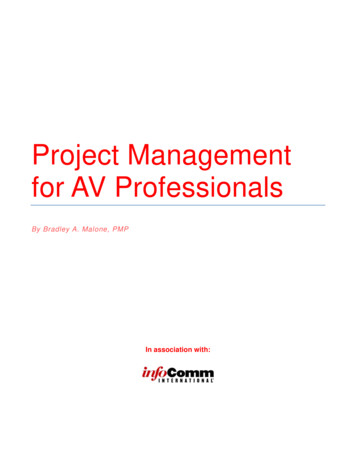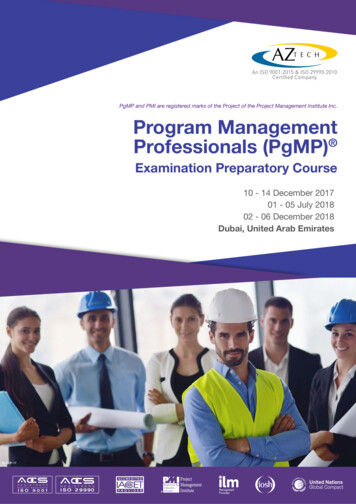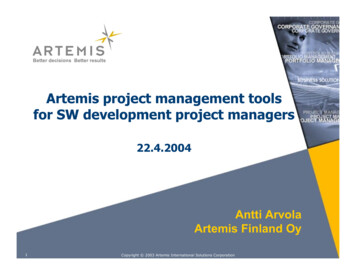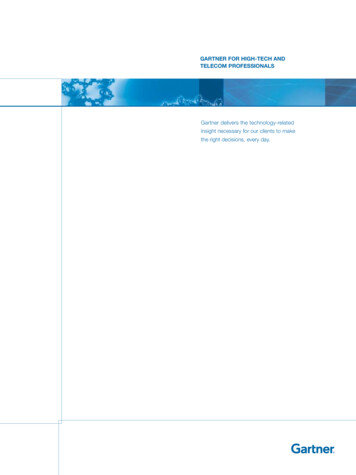
Transcription
Project Managementfor AV ProfessionalsBy Bradley A. Malone, PMPIn association with:
About the AuthorBradley A. Malone, PMP, is an InfoComm University senior instructor and president of TwinStar Consulting Company, an organizational excellence and program management consultingcompany serving multiple industries. He holds the Project Management Professional (PMP )designation from the Project Management Institute (PMI) and is one of PMI’s highest-ratedinstructors. Please share your thoughts with him at brad@twinstarconsulting.com.About InfoComm InternationalInfoComm International is the international trade association representing the professionalaudiovisual and information communications industries. Established in 1939, InfoComm hasmore than 5,000 members, including manufacturers, systems integrators, dealers anddistributors, independent consultants, programmers, rental and staging companies, end-usersand multimedia professionals from more than 80 countries. InfoComm International is theleading resource for AV standards, market research and news. Its training, certification andeducation programs set a standard of excellence for AV professionals. InfoComm Internationalis the founder of InfoComm, the largest annual conference and exhibition for AV buyers andsellers worldwide. InfoComm also produces trade shows in Asia, Europe, Latin America andthe Middle East. Additional information is available at www.infocomm.org.Project Management for AV Professionals, in association with InfoComm International 2
ForewordOver the last decade, the audiovisual integration industry has seen monumental advances intechnology and systems. With those advances come more difficult challenges when it comesto managing AV projects, which themselves have grown more complex and require greatercoordination and collaboration among numerous entities.Project management can no longer be an afterthought when it comes to pro AV. Nor should itbe treated as a necessary evil to selling and implementing systems and solutions. It mustbecome part of the culture of a successful AV integration company—and of the AV integrationindustry as a whole. Project management is much more than an additional role assigned toyour company’s best lead technician; it is a philosophy that needs to permeate theorganization. Mature project management is the answer to the question, “How do we sell,manage and implement projects for our clients in a professional and predictable manner?”I’ve seen incredible progress in the management and leadership of many organizations as theynavigate all the change that’s occurred in the pro-AV marketplace. The principles describedthroughout this e-book are foundational. That is, you apply them mostly by following them. Noadvanced degree is required, no magic pill available. What I promise — and what myexperience has been with leaders and individuals at companies that followed this guidance —is that hard work, perseverance and a willingness to take personal accountability triumphs.Mature project management requires changes to how an organization operates and how itmeasures success — from sales, engineering, procurement, and resource scheduling, toproject management, production, installation, programming, testing, training, commissioning,and service. Each role and function must begin to see the value and importance of the otherroles to creating successfully implemented projects. There is no inherent hierarchy or“specialness” of roles in a well-functioning company. Instead, there is a commitment to servingone another by adhering to standards and processes — taking the “right action” every time,instead of creating an exception.This e-book is dedicated to the many AV professionals whom I have had the privilege to meetover the last seven years working with InfoComm International as a senior instructor withinthe InfoComm University . I’ve had the pleasure of working directly with more than 50 smalland large audiovisual integration companies and technology management organizationsacross the globe. I’ve also learned an incredible amount through training more than 2,500participants in organizational project management maturity principles, alongside the othercommitted instructors and volunteers who make InfoComm University such an impactful part ofthis industry.Thank you for the opportunity to make a lasting difference. See you soon.Brad Malone, 2013Project Management for AV Professionals, in association with InfoComm International 3
ContentsChapter 1: The Elements of a Project . 5Chapter 2: Organizational Roles and Hands-Offs . 8Chapter 3: Creating Project Managers the Right Way . 10Chapter 4: Women in Project Management . 13Chapter 5: The Value of an Organization’s Vision . 15Chapter 6: Establishing Shared Values and Ethics . 17Chapter 7: AV Sales: Building Relationships and Managing Expectations . 20Chapter 8: What a Comprehensive Scope of Work Looks Like . 23Chapter 9: Scope Statements: Establishing Boundaries and Responsibilities . 26Chapter 10: Creating Common Sense, Communicating Assumptions and Risks . 28Chapter 11: Using a Work Breakdown Structure . 32Chapter 12: The Myth of the Perfect Estimate . 36Chapter 13: The Project Kick-Off Meeting: Setting a Stage for Success . 40Chapter 14: Better Processes, Better (More Profitable) Projects . 43Chapter 15: Resource Management: Getting What You Need from Workers . 47Chapter 16: Distinguish Competence from Behavior to Maximize Performance . 50Chapter 17: How to Keep a Project on Course . 54Chapter 18: Project Changes: Manage Them or Just Make Them? . 58Chapter 19: Project Closure: When is Done Really Done? . 61Chapter 20: Lessons Learned: The Remedy for Repetitive Project Pain . 64Chapter 21: Client Surveys: Closing the Loop, Maintaining the Relationship . 68Project Management for AV Professionals, in association with InfoComm International 4
Chapter 1The Elements of a ProjectThe mature practice of project management has become one of the key differentiators foraudiovisual companies that are capable of achieving long-term success. Mature projectmanagement practices lead to increased profit, client satisfaction, higher employee morale andoverall quality improvement.But many companies treat the subject of project management as a person, not as a thoughtprocess. They usually assign their best troubleshooter (or lead technician) to the role of projectmanager because that person, they believe, will be able to pull the project out of the fire once aproblem or crisis occurs. This strategy relies on that individual’s ability as a reactive problemsolver, but doesn’t foster proactive planning and up-front communication. The professionalproject manager’s most important role is to keep the project’s interrelated elements in balance,maintaining its integrity as project changes and variances begin to occur.To help illustrate these interrelationships, think of a project as a three-sided pyramid (below,viewed from above) with five major elements. These elements are initially generated by thesales person, as part of the proposal or bid process, and handed over to the project managerupon contract award. These elements must then be kept in balance through the skills of theproject manager — in other words, the sides of the pyramid must always stay connected,which isn’t the same as keeping them rigid and immovable. The project manager’s role is alsolike that of a newspaper reporter — asking questions of key stakeholders to discover theanswers that will make the project viable and successful and creating “common sense” amongthe numerous people who will interact during the project’s implementation. The projectmanager must be aware that although he/she may think his/her personal opinion is important,it’s not the most important opinion or answer — that belongs to the client.Let’s break down the five elements andconsider the pertinent questions that projectmanagers must ask. But before we do that,someone — be it the account or salesrepresentative — needs to ask the client themost important question: “What is thepurpose of this project?” The client’s answerhelps define the value that must beachieved, or the return on investment, fromthe client’s own perspective. Having thisanswer clearly defined provides meaningfulcriteria with which to make sound decisionslater in the project, when changes orvariances begin to occur.Project Management for AV Professionals, in association with InfoComm International 5
The first element is the scope of the deliverable that your company will be providing to theclient, whether that deliverable is a videoconference room, a home theater, a boardroom, or anauditorium. And the question to be asked is, “What are we delivering?” But sometimes moreimportantly, you need to ask, “What are we not delivering?” You should be able to tie yourdeliverables back to the purpose of the project in a cohesive manner — each deliverable playsa part in achieving the desired value.The second element is that of time, stemming from two questions. The first is, “How will thisdeliverable be designed, installed, commissioned, trained for, etc.?” This is a process- oractivity-based question, and the project manager relies on the AV company’s functionalmanagers and process owners (engineering, installation, programming, etc.) for thoseanswers. In a larger project, the project manager must also understand the activities of othertrades and the interdependencies with the AV company’s activities. The second question is,“How long will it take to deliver this project?” or “By when do you (the client) need this projectcompleted?” These are duration-based conversations and are often determined or requestedby the client.“By when” projects will have a constrained end date, such as a school opening, board meeting,or a concert. Rental and staging companies will deal almost exclusively with fixed-dateprojects. “How long” projects have flexibility in the timeline — the client would like the roomcompleted sometime in the next 6 to 10 weeks, for example. One of the worst things an AVcompany can start doing is turning flexible projects into fixed-date projects. This occurs whensales tells the client, “We can finish it in 6 weeks — no problem.”The third element is the cost associated with the resources and materials needed toaccomplish the project’s deliverables. This element also comprises three questions. The firstis, “Who is needed to fulfill this project?” It determines the skill set and competence required toaccomplish the activities needed to fulfill the project’s deliverables.The next cost question is, “What materials are required (plasma panels, cabling, microphones,racks, control systems, etc.)?” This is followed by asking, “How much?” as it pertains both tothe amount of hours needed from the project’s human resources, as well as the quantity ofequipment, materials and parts required. In my experience with AV companies, the amount ofhuman resource labor effort (including project management hours) required to fulfill a project isoften underestimated, or it is collapsed into the duration (time) element. Example: “We’ve onlygot one day to do the project, so I bid 8 hours — although it’s a 100 miles away.” In thiscontext, cost is very distinct from price — the client will be charged a price and the AVcompany will incur costs against that project. In the ideal world, price will always exceed costs(if profit is important).The fourth element, quality, is the volume of the pyramid (the insides) and is dependent upon— and impacted by — the prior three elements: scope, time and cost. The question that sales,engineering, implementation, and the project manager need to ask here is, “How good?” as itrelates to each of the three sides of the pyramid. How good (well) do the deliverables have tofunction? What are the performance specifications, their desired reliability, maintainability,availability, ease of use, etc? How good are the processes used to design, install, test, train,Project Management for AV Professionals, in association with InfoComm International 6
and commission the products and services to be delivered? Are there standards, proceduresor guidelines in place that must be followed, or does each individual do their assigned workhis/her own way (the difference between person-based quality and process-based quality)?How good are the human resources to be used on the project? Have they been well trainedand are they rewarded for performing in compliance with the established standards? How goodare the parts and materials being used? Does each individual piece meet the desired qualityspecifications, or will the ultimate deliverable suffer because components and functions are ofmix-match capabilities?Finally, the fifth element is risk, and it makes up the foundation of the project — or its stabilityand predictability. When it comes to risk, project managers need to ask, “How sure are weabout the conditions that could impact the outcome of this particular project?” The more similara project is to others the company has executed, the more predictable the outcome. Thereforethe project ought to be stable, the pyramid sitting on a firm foundation. The more unique aproject is (different materials, different client, different project team resources), the lesspredictable the outcome and weaker the project’s foundation.In order to make a project more stable (less risky), the project manager will typically have totweak one of the other elements, whether to increase cost, increase time, decrease quality, ordecrease scope.The project manager, if he/she is to keep the project in balance, must also have flexibility in atleast one of the primary elements (scope, time or cost). This flexibility is determined byprioritizing the three elements through a series of questions: Who has authority over which element? The client may have dictated the scope andtime, therefore the project manager needs to have authority over the cost element.Which primary element is most important to the client?Have these priorities been communicated? To whom? Is there agreement?Which element can vary (based on priority)?By how much can it vary (based on uncertainty — the more unique the project, the moreflexibility required)?Which is constrained (typically scope, time and/or quality)? By whom?In the AV market place, scope and time (duration) are often fixed, or constrained by the client.So is the ultimate price. The price may be fixed at the beginning of a project by the salesorganization, but the project manager must have flexibility in the costs of the project, especiallywith regard to the amount of effort required by the project team resources.The more unique the project, the wider the variance threshold required by the project manager.This does not mean they have the ability to authorize undisciplined changes to the scope ofthe project or its deliverables, but they must be allowed some measure of variance, based onthe skill levels of the estimated resources vs. the skill levels of the actual resources assigned.Project Management for AV Professionals, in association with InfoComm International 7
Chapter 2Organization Roles and Hand-OffsIn my experience managing projects — and in working with companies that are also attemptingto manage projects — a key determinant of success or failure is the handoff between an AVcompany’s different roles and functions. In small companies, where each person is performingmultiple functions, there are fewer handoffs, and less need for extensive and thoroughcommunication and the building of “common sense” across a larger group of people.Employees at a small company also have the chance to conduct many conversations with oneanother. They get a good understanding of what’s being communicated. This luxury tends toget lost as a company grows, even as cross-functional communication becomes more of anecessity. Such handoffs — of information, responsibilities, client relationships, etc. — canactually be a curse if not handled well.The chart below represents a project lifecycle. There are five to seven visible roles, andseveral critically important roles not shown (procurement, finance, coordinator/administrator,etc.). Each of these roles has specific informational needs in order to perform their functionseffectively and efficiently:1. Sales should understand the purpose behind the client’s request, their measures ofsuccess, and a functional description of what the client would like to achieve. They need toprovide this context to the sales or design engineer to make the most applicable design.2. Engineering and sales must communicate throughout the design process, ultimatelyproviding the client a solution that adds value, while also giving the project manager andtechnicians a design that is executable and a drawing that is complete, including up-to-dateequipment and parts.3. Project management must receive pertinent client information from sales and put it quicklyto use, informing the client of receipt of the purchase order and the project’s initiation, plus arough milestone schedule and next steps. They also need to understand any complexitieswithin the engineering design and have a good idea of how that design will fulfill the client’spurpose.4. The technicians — even more than the project manager — need to understand anycomplexities within the engineering design. They also need to know where they’re going, whothey need to talk to, and whether all of the equipment and materials are at the job site or not.They also need to know the condition of the job site in terms of readiness for installation.5. Depending on the organization, there may be several handoffs within the installationfunction (head-end, production, install, programming, training, commissioning, etc.). TheseProject Management for AV Professionals, in association with InfoComm International 8
handoffs ultimately should be managed by the project manager or coordinator, againdepending on the organization and size of the project.6. The project manager and sales must collaborate and coordinate on any change requeststhat arise throughout the project lifecycle — the project manager handles cost, salescommunicates price. There is often a conflict, or gap in communication, between sales andproject management. This conflict is often viewed as a power struggle (“Who’s in charge?”). Itshould be thought of in terms of who is playing a primary role versus a supporting role —neither more important than the other, but both incredibly valuable in maintaining long-termclient relationships and organizational profitability.7. When it comes to commissioning, both service and sales need to be brought up to speedon correct drawings and any outstanding items that could ultimately reflect poorly on theorganization.8. Project managers and technicians need to close the loop with sales and engineering tohighlight assumptions that must be updated, any variance between project actuals andestimates, and w
Project Management for AV Professionals, in association with InfoComm International 2 About the Author . The fourth element, quality, is the volume of the pyramid (the insides) and is dependent upon — and impacted by — the prior three











